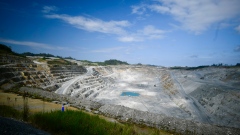Nov 30, 2023
Zelenskiy Faces Manpower Dilemma in Ukraine’s Stalled Offensive
, Bloomberg News
(Bloomberg) -- A plan to draft more Ukrainian men into the army has been sitting on President Volodymyr Zelenskiy’s desk since June. The wartime leader so far has defied pressure from the military to sign it.
Instead, Zelenskiy last week asked his government and top brass for a more comprehensive package, one better tailored to a nation exhausted by a war and preparing for another winter of fighting. It again put off the blueprint, approved by Ukraine’s parliament, to lower the draft age during war for men with no military experience to 25 from 27.
“The law should have taken effect — the parliament fully backed it,” Roman Kostenko, a lawmaker on the parliamentary defense committee, said in an interview. “Conscription is taking place with difficulty now.”
The delay exposes the mounting problem of filling Ukraine’s military ranks almost two years into a conflict that Zelenskiy’s top general says has settled into a standoff. Although Moscow has had its own struggles with conscription, Ukraine’s plight puts it at a potential disadvantage to Russia, a vast nation whose population of 143 million is more than triple that of prewar Ukraine.
Zelenskiy’s reluctance to sign the law stems from his wish to see a clear plan for what his military seeks to achieve with a call-up, how new recruits will be deployed and how to design a rotation for those who’ve been on the battlefield for 21 months, according to people familiar with his thinking.
“I expect a more thorough analysis of each of these issues by both the government and the military and concrete proposals,” Zelenskiy said on Friday after meeting military leaders.
But the delay is worrying the military. The legislation would give recruitment officers access to an additional 140,000 potential conscripts, according to military estimates. Ukraine’s popular army chief, Valeriy Zaluzhnyi, wrote in a Nov. 1 essay for The Economist that current conscription rules contained gaps that allow citizens “to evade their responsibilities.”
The general referred to a call-up that covers most Ukrainian men between 18 and 60, though provides exemptions for those under 27 without experience in military service, unless they volunteer. The average age for a soldier in Ukrainian army is above 40.
Kostenko, 40, who is also fighting in southern Ukraine, said the military is struggling after long queues at recruitment centers last year have dwindled, with volunteer fighters long at the front lines.
Sense of Gloom
Even as freezing temperatures grip the country, fighting has continued. Russian troops have advanced on the Ukrainian-held city of Avdiivka in the east, while much of the fighting on the southern front in the Zaporizhzhia region – where Kyiv had aimed to make gains in the summer – has ground to standstill.
Resistance to conscription is also taking shape. In the central Ukrainian city of Poltava, a recruitment drive this year brought in about a 10th of what was targeted, a regional official said. In a case that drew media attention, a man ferrying children to a Taekwondo tournament in Uzhhorod on the Slovak border was seized from his motel room and served call-up papers. Two recruitment officers were charged with beating draft targets in the western city of Ternopil.
The government won’t release data on the effectiveness of the call-up.
The latest manpower struggle coincides with a sense of gloom settling over Ukraine, with a counteroffensive that’s yielded few results fueling a sense that the war won’t end any time soon. Add to that the prospect of winter missile strikes and anxiety over deliveries from allies and Zelenskiy’s political calculus gets harder.
“The president’s office fears that approval of this law may escalate tensions,” Volodymyr Fesenko, head of the Penta research institute in Kyiv, said. “It may also boost ‘peace at any cost’ sentiment. This trend — though not very popular yet — is already here and it may intensify.”
Recruitment has had a tortuous history on both sides of the front line, dating at least to social tensions from the Soviet Union’s 1979 invasion of Afghanistan, a war that helped precipitate the country’s collapse.
President Vladimir Putin has been careful to avoid suggestions that the country plans a new mobilization after hundreds of thousands of Russians fled the country after he announced 300,000 would be drafted into military service in September last year.
Opinion polls showed a spike in public alarm among Russians after partial mobilization, as people worried their families may be drawn into the fighting. With Putin likely preparing for a fifth presidential term in an election scheduled for March, officials are playing down speculation that a new drive may be announced after the vote.
Kremlin officials set a target of recruiting as many as 400,000 contract soldiers this year. Former President Dmitry Medvedev, now the deputy head of Russia’s security council, claimed in October that 385,000 had joined the ranks of the military so far, with as many as 1,600 recruits a day.
Russian advertising campaigns lean on calls to patriotism to join up, while topping the offer with relatively high levels of military pay, a figure that can run to three times the average salary.
Ukraine’s military authorities have had support for broadening the call-up from allies. Former UK Defense Secretary Ben Wallace, writing in an op-ed for The Telegraph in October, encouraged Kyiv to enlist more younger men in its aim to win the war, comparing the effort with the Kremlin’s tactics.
“I understand President Zelenskiy’s desire to preserve the young for the future,” Wallace wrote. “But the fact is that Russia is mobilizing the whole country by stealth.”
--With assistance from Olesia Safronova and Tony Halpin.
©2023 Bloomberg L.P.








